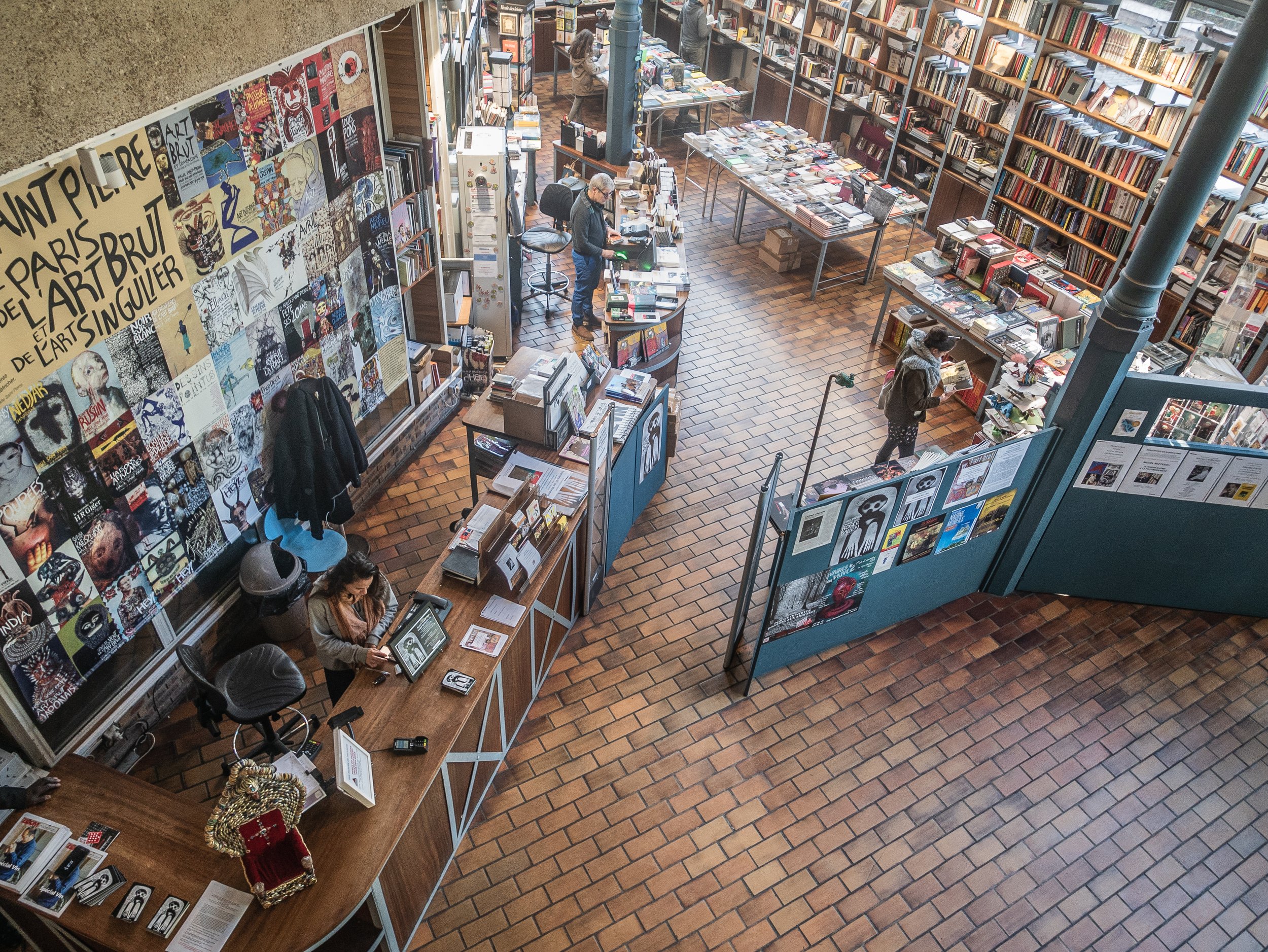 "The World of Roger Ballen" is an exhibition of the work of one of the most innovative contemporary photographers, showing currently and until July 2020 at the Halle St Pierre in Montmartre, Paris. The gallery itself is a light airy space on two levels, the upper galleries being accessed from a balcony overlooking the ground floor cafe and bookshop. It specialises in showing 'Art Brut' or outsider art, makes it particularly appropriate for this work. The current exhibition uses the upper floor for a fairly standard formal presentation of a generous selection Ballen's photographs as large framed prints, with some of his drawings directly on the walls and some of the props used in his work. Downstairs, the gallery contains recreations of several of the spaces he has photographed in the form of a series of vignettes, again using the photographer's own props, models, artworks and even a life sized model of himself with his Rolleiflex on a rotating pedestal. There was also a separate projection room showing a sequence of short films of the places and people he has worked with.
"The World of Roger Ballen" is an exhibition of the work of one of the most innovative contemporary photographers, showing currently and until July 2020 at the Halle St Pierre in Montmartre, Paris. The gallery itself is a light airy space on two levels, the upper galleries being accessed from a balcony overlooking the ground floor cafe and bookshop. It specialises in showing 'Art Brut' or outsider art, makes it particularly appropriate for this work. The current exhibition uses the upper floor for a fairly standard formal presentation of a generous selection Ballen's photographs as large framed prints, with some of his drawings directly on the walls and some of the props used in his work. Downstairs, the gallery contains recreations of several of the spaces he has photographed in the form of a series of vignettes, again using the photographer's own props, models, artworks and even a life sized model of himself with his Rolleiflex on a rotating pedestal. There was also a separate projection room showing a sequence of short films of the places and people he has worked with.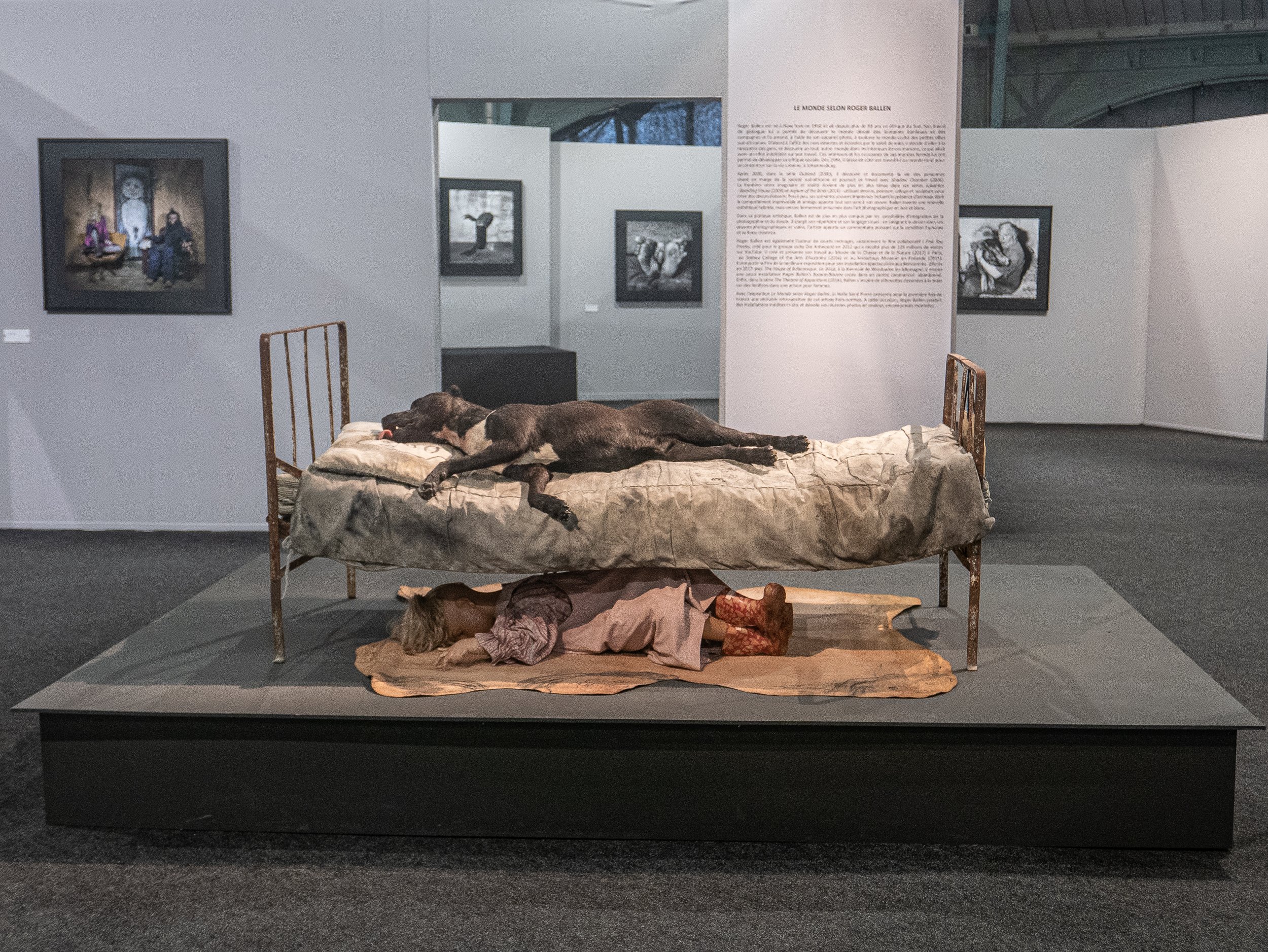
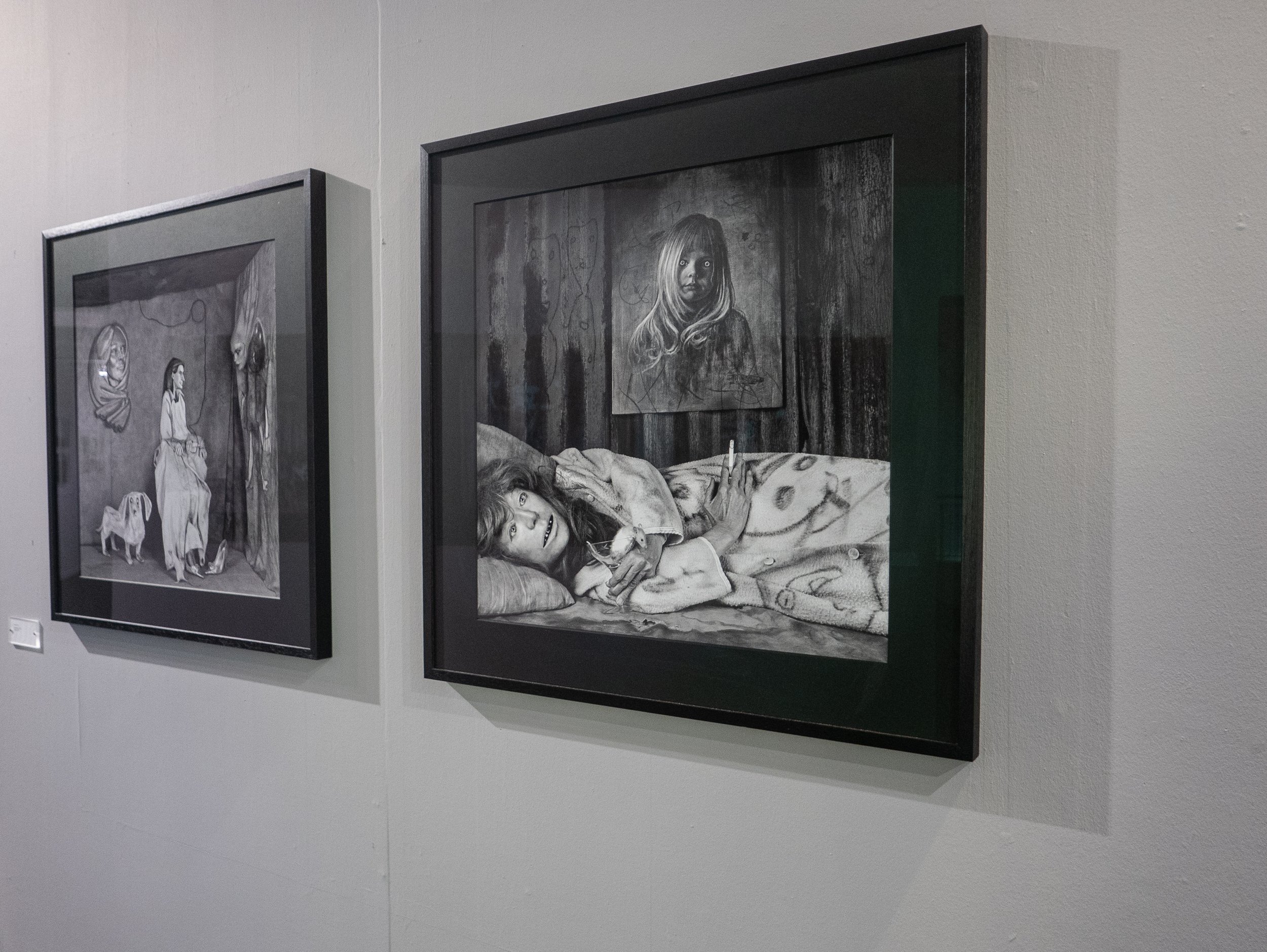
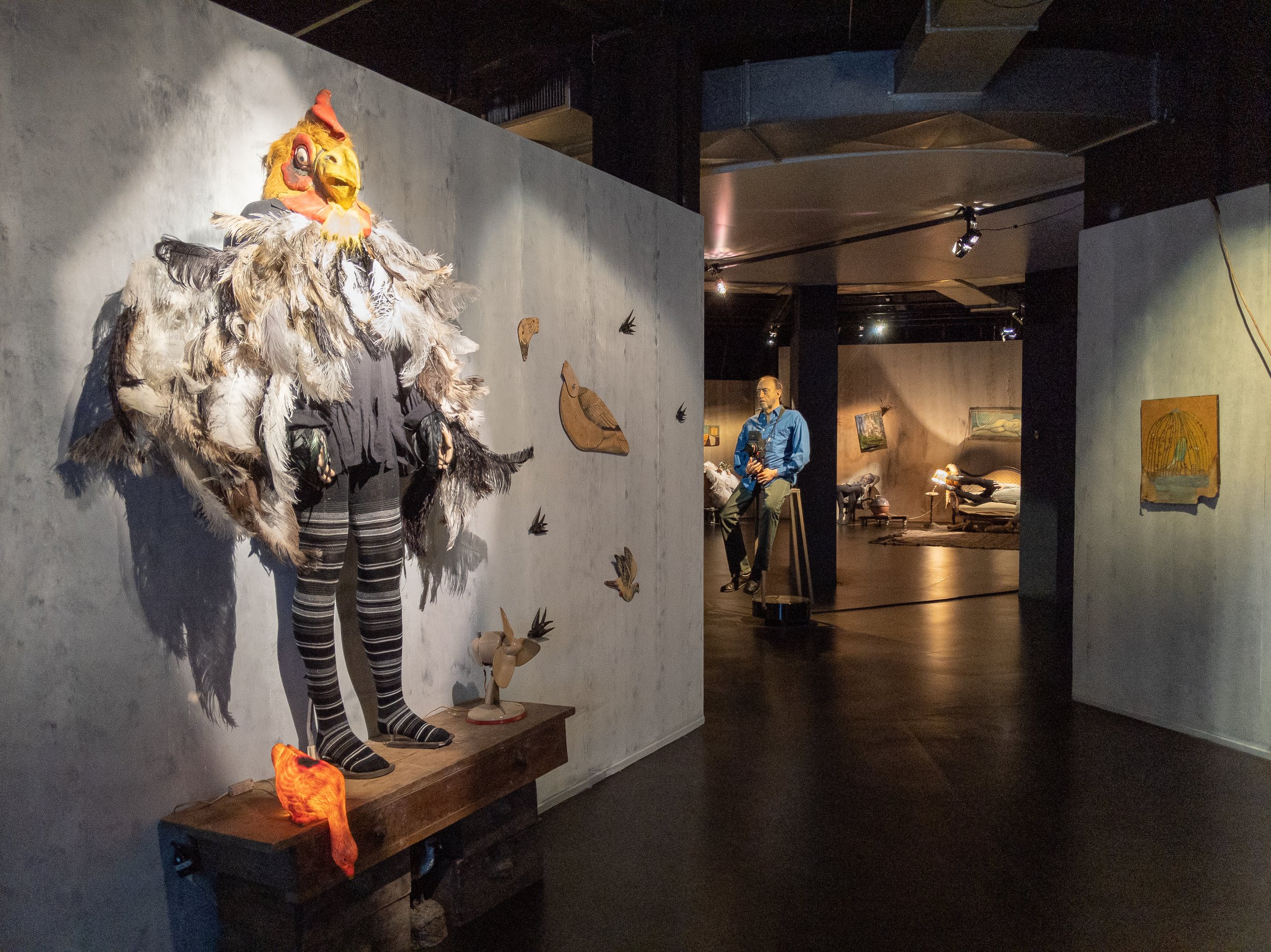
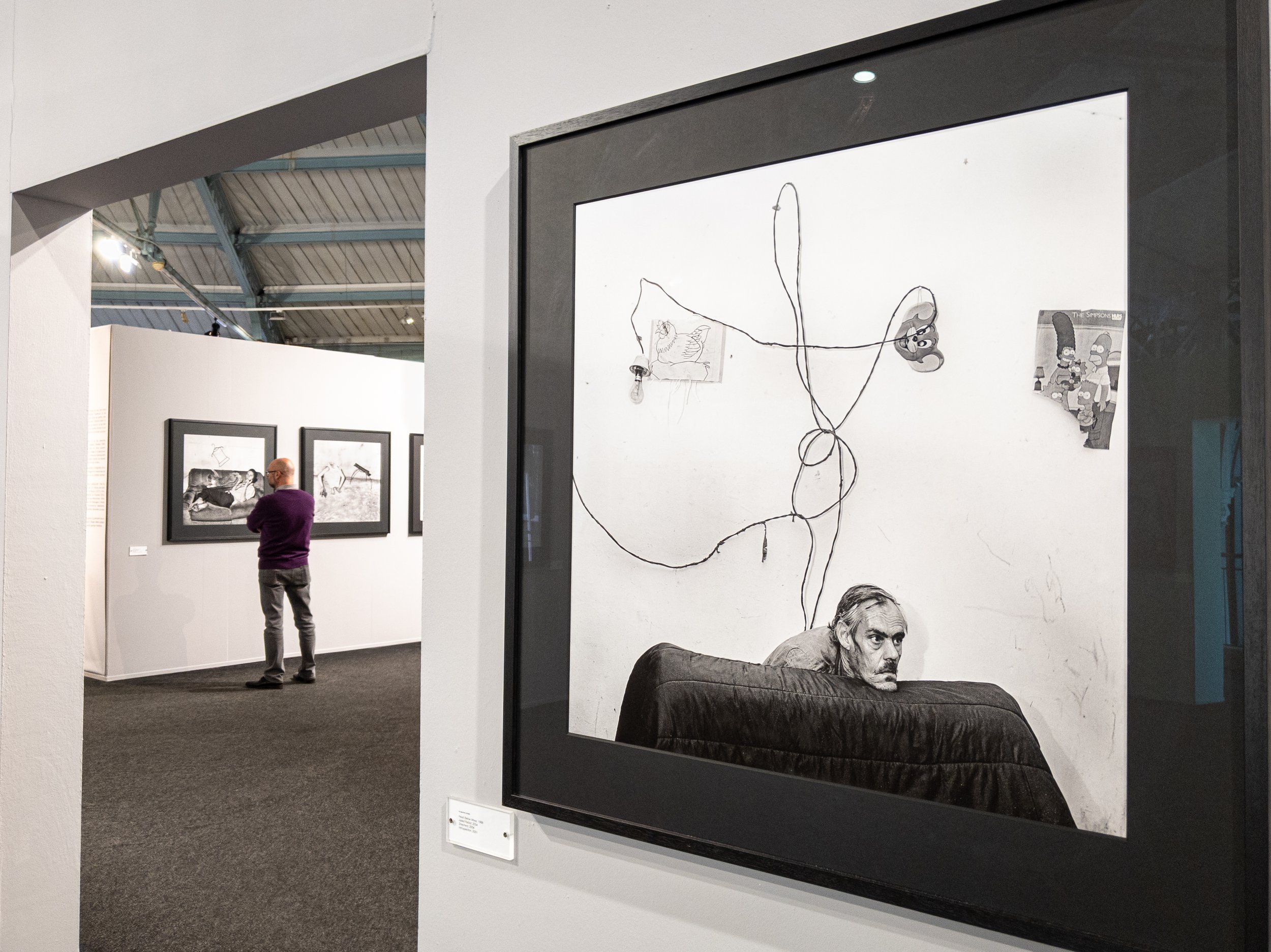
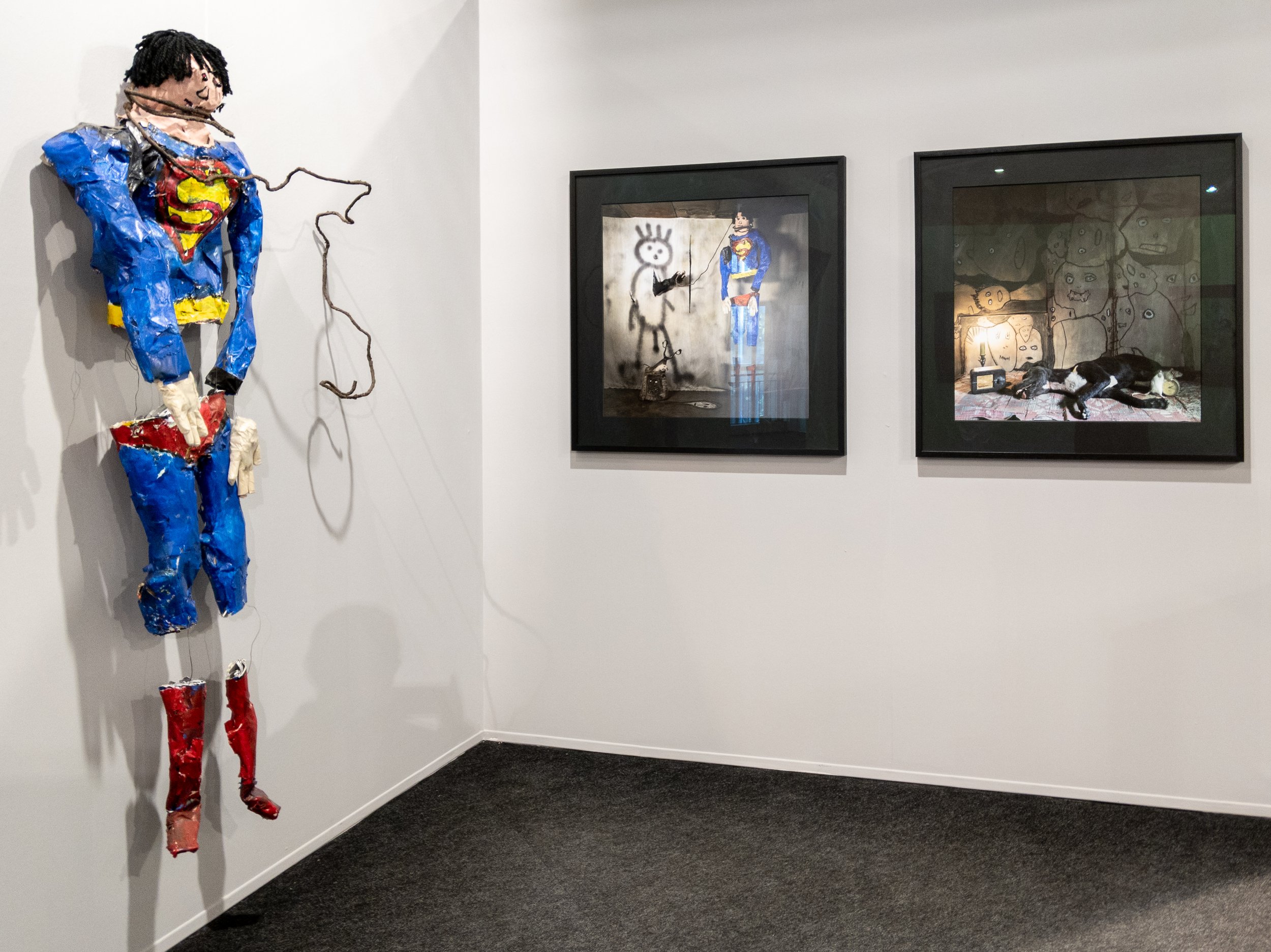
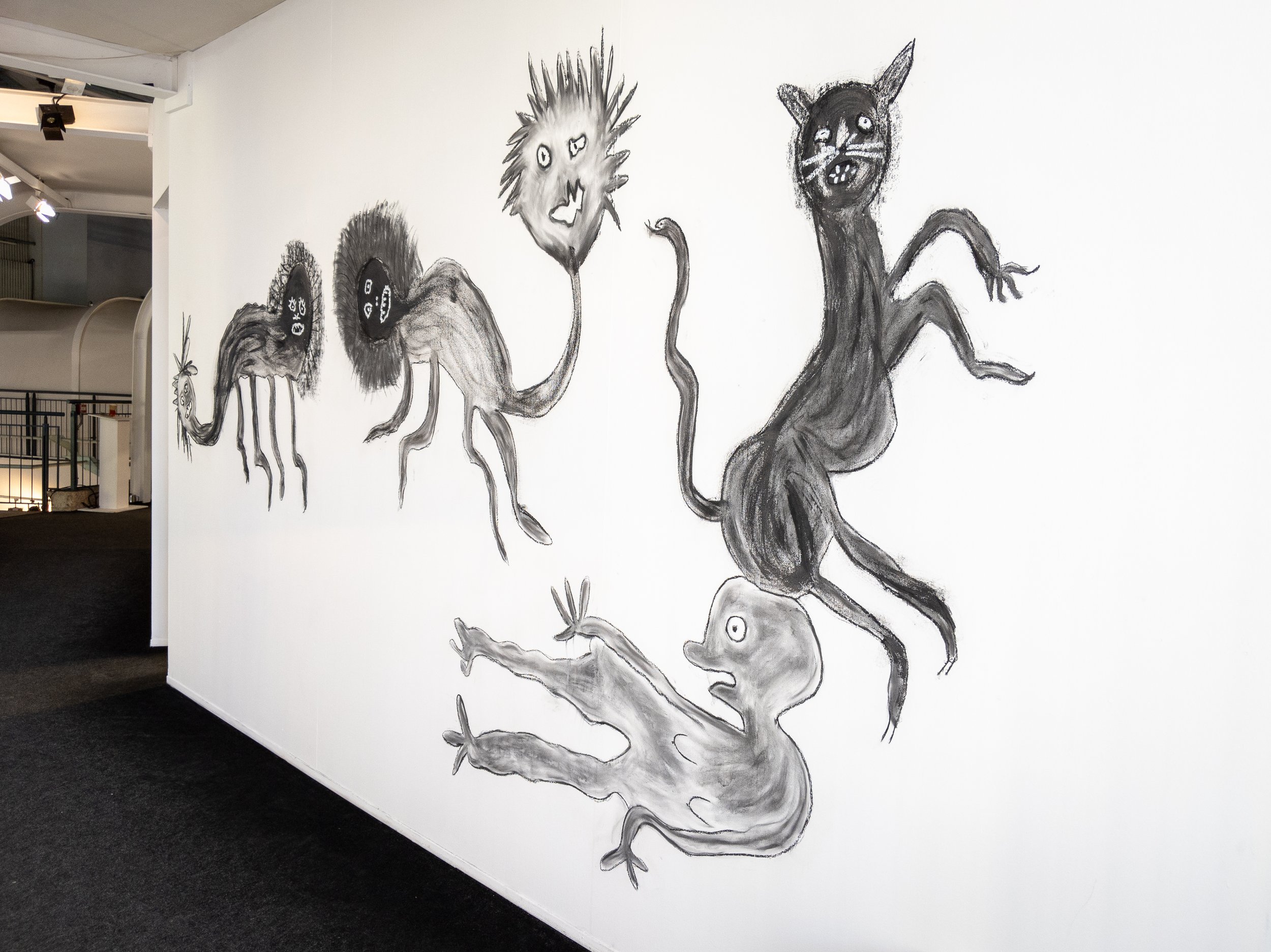
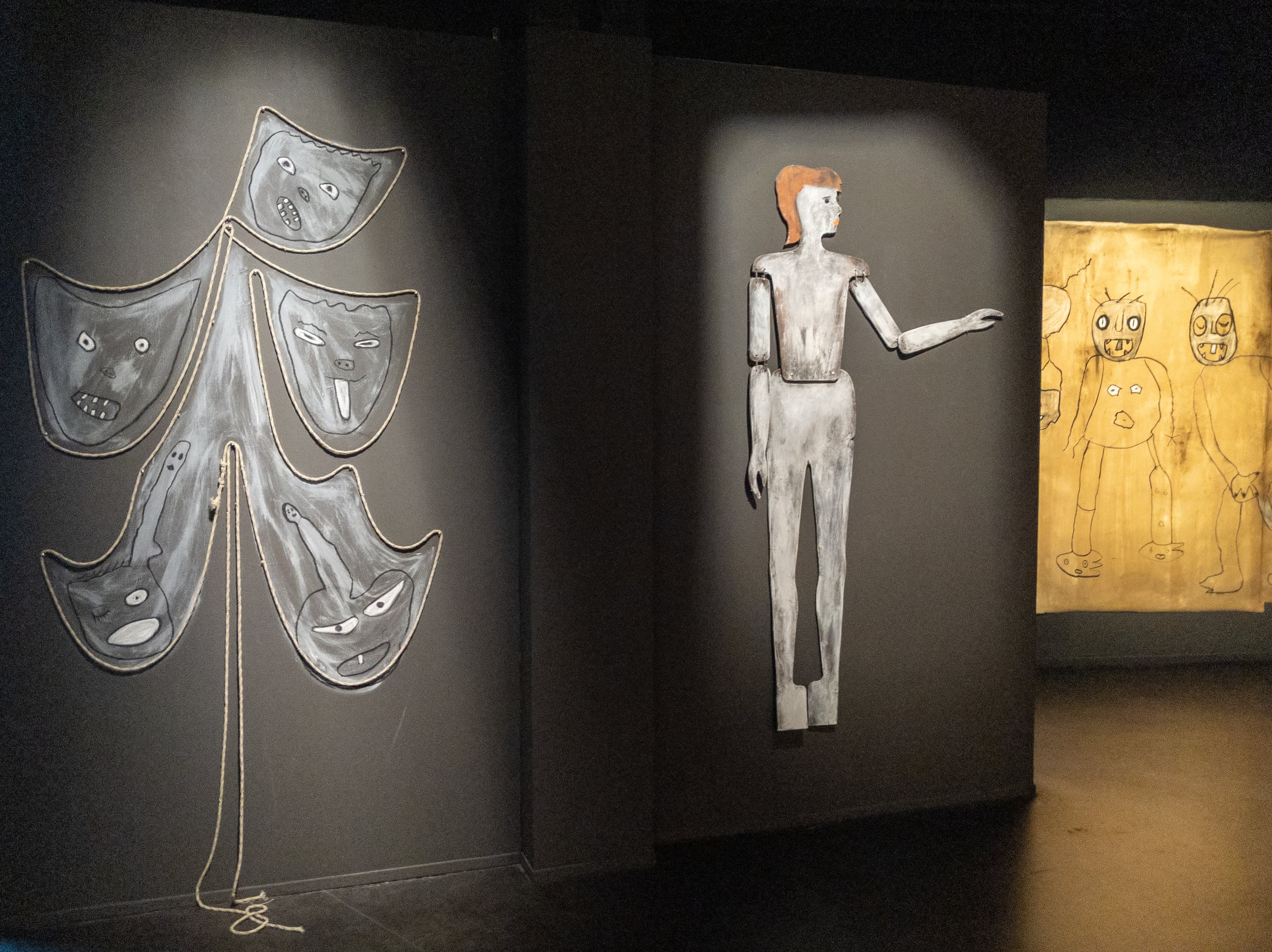


 As can be seen above, the places and people he has photographed would perhaps best be described as being on the very fringes of society and the images are imaginative, darkly humorous, intriguing and sometimes challenging. The films shown at the gallery are also available on his website and perhaps give a better feel for the atmosphere in which his work is created. Ballen has recently been interviewed for the October edition of the British Journal of Photography by Michael Grieve and an interview with him at Paris Photo is also available on their websitewww.rogerballen.comhttps://www.hallesaintpierre.org/wp-content/uploads/2012/01/DP-HSP_Roger-Ballen.pdfGrieve M. 'The World according to Roger Ballen', British Journal of Photography, Issue No.7888, pp 38-49, October 2019.
As can be seen above, the places and people he has photographed would perhaps best be described as being on the very fringes of society and the images are imaginative, darkly humorous, intriguing and sometimes challenging. The films shown at the gallery are also available on his website and perhaps give a better feel for the atmosphere in which his work is created. Ballen has recently been interviewed for the October edition of the British Journal of Photography by Michael Grieve and an interview with him at Paris Photo is also available on their websitewww.rogerballen.comhttps://www.hallesaintpierre.org/wp-content/uploads/2012/01/DP-HSP_Roger-Ballen.pdfGrieve M. 'The World according to Roger Ballen', British Journal of Photography, Issue No.7888, pp 38-49, October 2019.
'As it is' - a Zed Nelson film with David Hurn at work in the Welsh landscape
On 16th October 2019, Oriel Mostyn in Llandudno presented the first showing of 'As it is', a new short film by Zed Nelson in collaboration with Magnum photographer David Hurn, followed by a talk and question and answer session with Zed Nelson and Alfredo Cramerotti, Director of the gallery. This was combined with the opening of an exhibition of small selection of David Hurn's photographs, about ten each from his earlier monochrome work on street life in Wales and from his current project documenting the ongoing changes in the landscape of Wales. The film documented Hurn in the process of making these more recent images while in conversation with Zed Nelson, in which he described his approach to the project.Hurn is not generally regarded as a landscape photographer and acknowledged that at the age of 85, this could appear to be a change of genre from his better known largely monochrome documentary photography but explained that the aim of this work is to document the landscape 'as it is' currently, with particular emphasis on the effects of human habitation and exploitation rather than its' natural beauty. Each scene in the film was based on the thought processes going into the making of a specific individual photograph, several of which were made locally in North Wales.The conversational approach and clear rapport between the two photographers made the film enjoyable to watch as well as informative. The Q and A session which followed was quite lively and largely positive though one person questioned the use of the title on the basis that the photographs represent David Hurn's (masculine) views on the state of the Welsh landscape as he sees it rather than 'As it is'. Hurn has been quoted as saying he regards the concrete structures in the breakwater shown above as "one of the two best sculptures in Wales". From my own point of view, the most obvious criticism is the fact that the exhibition of such an important photographer's work was located in a small side gallery and consisted of such a disappointingly small number of his photographs.https://www.mostyn.org/event/exhibition-opening-event-film-screening-artist-talkImage copyright: David Hurn/ Magnum Photos. Sourced on 30/10/2019 at: https://www.canon-europe.com/pro/stories/david-hurn-documenting-landscapes/
Generating interest in plastic waste
 In trying to highlight the more serious issues created by careless disposal of waste plastic much of which ends up in the sea, I have attempted to make photographs of waste plastic on beaches but felt that most of the images were disappointingly ineffectual (boring). The image above and the featured image were made at Traeth Cymyran on Anglesey a few weeks after a storm at Holyhead harbour destroyed the pontoons in the marina which used blocks of polystyrene for buoyancy, spreading fragments like that in the photograph for many miles along the coast. A huge variety of non-biodegradable materials are washed onto beaches, even in the most remote areas, like the island off the Atlantic coast of the North West of Ireland in the example below.
In trying to highlight the more serious issues created by careless disposal of waste plastic much of which ends up in the sea, I have attempted to make photographs of waste plastic on beaches but felt that most of the images were disappointingly ineffectual (boring). The image above and the featured image were made at Traeth Cymyran on Anglesey a few weeks after a storm at Holyhead harbour destroyed the pontoons in the marina which used blocks of polystyrene for buoyancy, spreading fragments like that in the photograph for many miles along the coast. A huge variety of non-biodegradable materials are washed onto beaches, even in the most remote areas, like the island off the Atlantic coast of the North West of Ireland in the example below.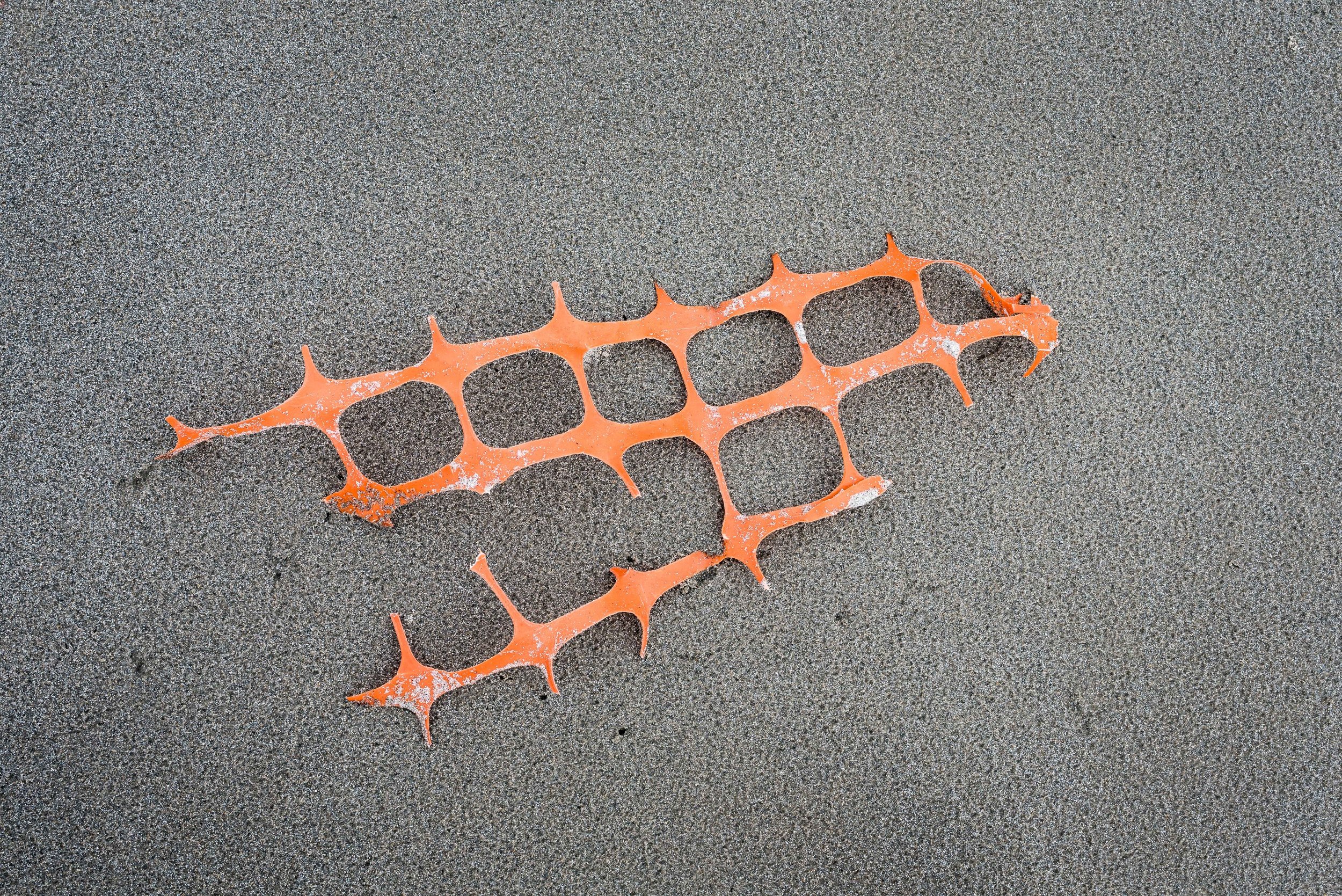 I have followed with interest, the amount of media coverage recently given to the environmental impact of waste plastic and one contemporary photographer who has published several very effective bodies of work in this area, is Mandy Barker (born 1964). In an extensive interview with Mike Simmons in 'Photographers and Research', she explained that she also initially tried to make her photographs in situ, where it washed up on the beach but felt that the familiarity of these images resulted in people being unlikely to engage with them. She found that by taking the objects into the studio and photographing them in saturated colour against a solid black background, she could create the impression of an alien life form deep in the sea, suspended underwater. For her first series 'Indefinite' she used solitary objects but in her subsequent projects 'Soup' and 'Shoal', she used digital montages of multiple samples of plastic objects collected from beaches, varying their size in the image to create an impression of perspective depth and positioning them in ways which mimicked the circulation of underwater currents.The other element which adds impact to her images is her use of imaginative captioning, giving viewers limited but factual contextual detail; sometimes a grid reference, sometimes an indication of the type of plastic debris or how long it would take to degrade. She also went to great lengths to ensure the accuracy of her information, by collaborating and making extensive field trips with oceanographic scientists and has presented her photographs at prestigious ecology conferences. For a series of images titled 'PENALTY', made to exploit the publicity surrounding the 2014 F.I.F.A. World Cup, she used a social media call-out for donations from the public, to collect and photograph 769 plastic footballs collected from 144 beaches in 41 countries around the world.A retrospective of her work is currently on show at the Royal Photographic Society in Bristol and 'Beyond Drifting' her most recent series of photographs, is featured this month in Black and White Photography magazine. These abstract monochrome images are captioned with pseodo-Latin species names and framed in a circular mount, to mimic the appearance of photographs of plankton taken using a microscope but are in reality plastic debris, flowers, toys, tricycle wheels, a Barbie dolls arm and a plastic yoke from a six-pack. In the accompanying article she explains that the images were taken with old film cameras on out-of-date grainy film, with movement blur which on the first occasion, occurred when in the darkness of her studio, she inadvertently knocked into the tank in which they were suspended during a long exposure, a 'happy accident' which she quickly recognised and exploited to make the rest of the series.Her work has moved on a long way from the simple photographs of artifacts on the beach demonstrating the value of her extensive research, her collaborations with experts in the field and her willingness to experiment with different formats to produce photographs of plastic waste, which are powerful enough to draw in viewers and in the process encourage them to engage with an issue of serious significance.
I have followed with interest, the amount of media coverage recently given to the environmental impact of waste plastic and one contemporary photographer who has published several very effective bodies of work in this area, is Mandy Barker (born 1964). In an extensive interview with Mike Simmons in 'Photographers and Research', she explained that she also initially tried to make her photographs in situ, where it washed up on the beach but felt that the familiarity of these images resulted in people being unlikely to engage with them. She found that by taking the objects into the studio and photographing them in saturated colour against a solid black background, she could create the impression of an alien life form deep in the sea, suspended underwater. For her first series 'Indefinite' she used solitary objects but in her subsequent projects 'Soup' and 'Shoal', she used digital montages of multiple samples of plastic objects collected from beaches, varying their size in the image to create an impression of perspective depth and positioning them in ways which mimicked the circulation of underwater currents.The other element which adds impact to her images is her use of imaginative captioning, giving viewers limited but factual contextual detail; sometimes a grid reference, sometimes an indication of the type of plastic debris or how long it would take to degrade. She also went to great lengths to ensure the accuracy of her information, by collaborating and making extensive field trips with oceanographic scientists and has presented her photographs at prestigious ecology conferences. For a series of images titled 'PENALTY', made to exploit the publicity surrounding the 2014 F.I.F.A. World Cup, she used a social media call-out for donations from the public, to collect and photograph 769 plastic footballs collected from 144 beaches in 41 countries around the world.A retrospective of her work is currently on show at the Royal Photographic Society in Bristol and 'Beyond Drifting' her most recent series of photographs, is featured this month in Black and White Photography magazine. These abstract monochrome images are captioned with pseodo-Latin species names and framed in a circular mount, to mimic the appearance of photographs of plankton taken using a microscope but are in reality plastic debris, flowers, toys, tricycle wheels, a Barbie dolls arm and a plastic yoke from a six-pack. In the accompanying article she explains that the images were taken with old film cameras on out-of-date grainy film, with movement blur which on the first occasion, occurred when in the darkness of her studio, she inadvertently knocked into the tank in which they were suspended during a long exposure, a 'happy accident' which she quickly recognised and exploited to make the rest of the series.Her work has moved on a long way from the simple photographs of artifacts on the beach demonstrating the value of her extensive research, her collaborations with experts in the field and her willingness to experiment with different formats to produce photographs of plastic waste, which are powerful enough to draw in viewers and in the process encourage them to engage with an issue of serious significance.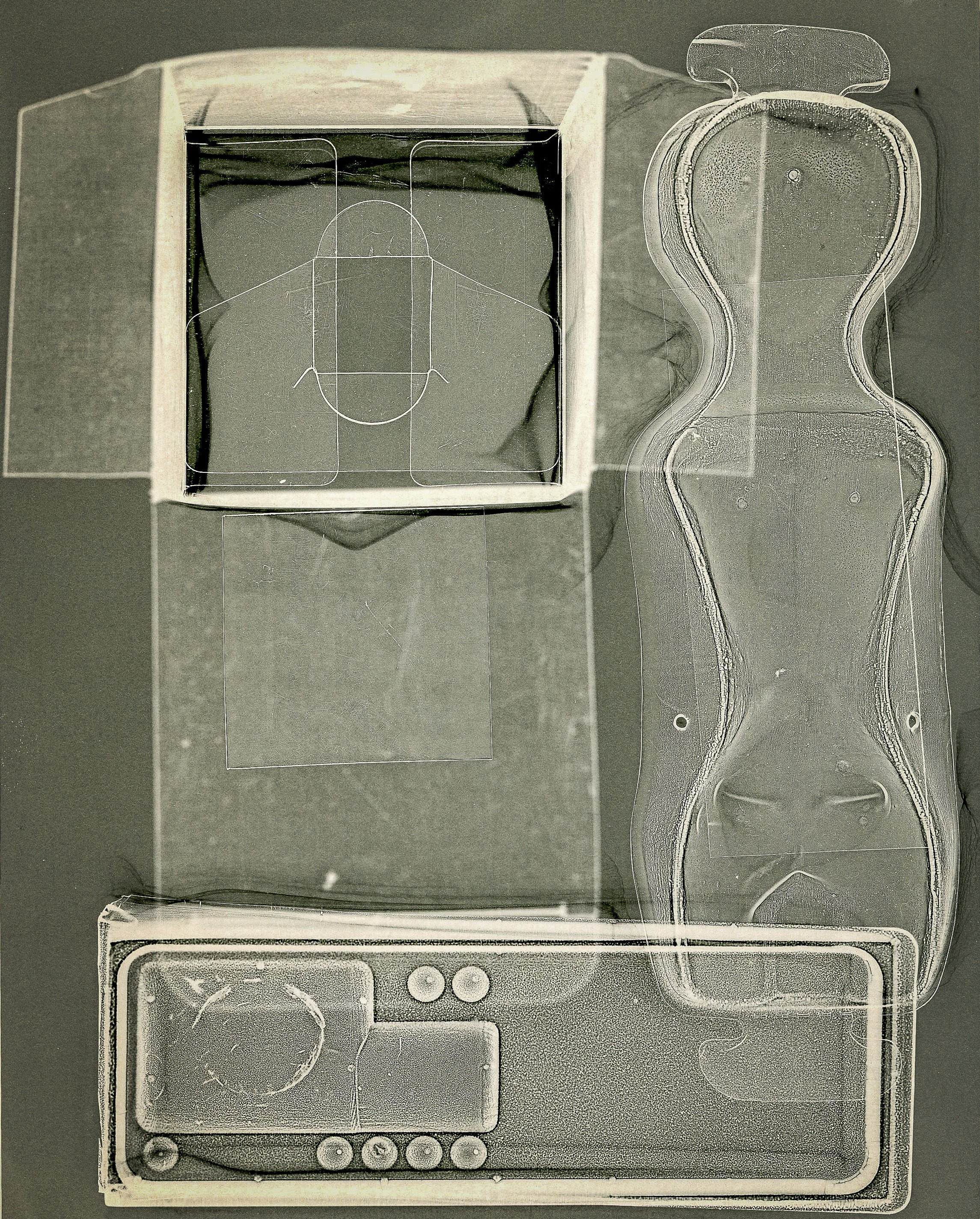 I have been making close-up photographs of the textural detail in waste packaging intermittently for several years. My original motivation for this was simply the challenge of trying to find something aesthetically pleasing in a mundane subject, which would not normally be considered as 'photogenic'. I also enjoy using isolation of detail, distortion of scale or unusual lighting to create something ambiguous, leaving the viewer unsure of what they are looking at. The fact that clear or translucent forms of packaging are very effective materials for creating photograms in the darkroom was a fortuitous coincidence, which has taken my own work in a potentially more interesting direction. Could this be an alternative approach to raising awareness by investigating the factors, other than their contents and practical convenience, which attract consumers to continue using them.Barker M (2019). 'Mandy Barker Photography' (Photographers website), Accessed on 2 May 2019 at: https://mandy-barker.com/Calder T (2019). 'Beyond Drifting' (Interview with Mandy Barker). Black and White Photography, Lewes East Sussex; Guild of Master Craftsman Publications. Issue No. 229, pp 28 - 35.Royal Photographic Society (2019). 'Mandy Barker: Altered Ocean Exhibition', Open: 4 April - 23 June 2019. Location: RPS House, Bristol. Information Accessed 2 May 2019 at: www.rps.org/exhibitions-and-competitions/mandy-barkerShukman D (2019). 'Plastic in the Ocean' (BBC iplayer film), Accessed on 14 April 2019 at: https://www.bbc.co.uk/programmes/p069vjw6Plastic-in-the-OceanSimmons M (2017). 'Case Sudy: Mandy Barker'. In: Read S and Simmons M 'Photographers and Research', Abingdon Oxon. and New York, Routledge, pp 126 - 139.
I have been making close-up photographs of the textural detail in waste packaging intermittently for several years. My original motivation for this was simply the challenge of trying to find something aesthetically pleasing in a mundane subject, which would not normally be considered as 'photogenic'. I also enjoy using isolation of detail, distortion of scale or unusual lighting to create something ambiguous, leaving the viewer unsure of what they are looking at. The fact that clear or translucent forms of packaging are very effective materials for creating photograms in the darkroom was a fortuitous coincidence, which has taken my own work in a potentially more interesting direction. Could this be an alternative approach to raising awareness by investigating the factors, other than their contents and practical convenience, which attract consumers to continue using them.Barker M (2019). 'Mandy Barker Photography' (Photographers website), Accessed on 2 May 2019 at: https://mandy-barker.com/Calder T (2019). 'Beyond Drifting' (Interview with Mandy Barker). Black and White Photography, Lewes East Sussex; Guild of Master Craftsman Publications. Issue No. 229, pp 28 - 35.Royal Photographic Society (2019). 'Mandy Barker: Altered Ocean Exhibition', Open: 4 April - 23 June 2019. Location: RPS House, Bristol. Information Accessed 2 May 2019 at: www.rps.org/exhibitions-and-competitions/mandy-barkerShukman D (2019). 'Plastic in the Ocean' (BBC iplayer film), Accessed on 14 April 2019 at: https://www.bbc.co.uk/programmes/p069vjw6Plastic-in-the-OceanSimmons M (2017). 'Case Sudy: Mandy Barker'. In: Read S and Simmons M 'Photographers and Research', Abingdon Oxon. and New York, Routledge, pp 126 - 139.

